Limited Edition books are a melding of fine literature and the art of fine printing. Four books in our vault are lovely examples of an author’s and a publisher’s joint enthusiasm for a unique presentation of a text.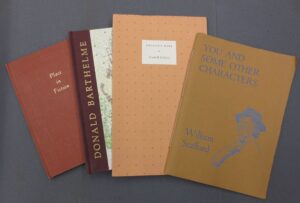
“A limited edition book is one where the number of copies in the print run has been strictly defined prior to its issue, and that number is substantially less than a standard print run, and then no further print runs are issued after the first printing has sold out… [These] books may also contain additional features such as better quality paper, extra illustrations, author signatures, different cover art, etc.” (“Limited Edition Books”).
“Gwilan’s Harp” is a story by Ursula Le Guin that was published by the Lord John Press in Northridge, California in 1981. In the back of this book, you will find a page with a limitation statement, which in this case states that this book is number 298 of 300 copies printed.
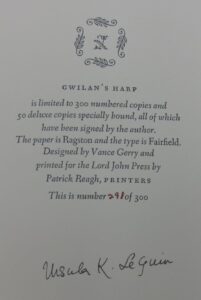 Details about the paper used for printing this book, what type font was used, who designed the book, who printed the book, and who published the book may be listed. In addition, the author’s autograph may be found on this page, too.
Details about the paper used for printing this book, what type font was used, who designed the book, who printed the book, and who published the book may be listed. In addition, the author’s autograph may be found on this page, too.
Herb Jellen of Boston, an avid collector of autographs and first editions, started the Lord John Press, which published Le Guin’s story. From 1976-2006 Jellen published limited editions in printing runs of 150 or 300 copies, that were signed by the authors. The name “Lord John Press” came from Jellen’s “love of [the] authors: John Barth, John Cheever, John Fowles, John Gardner, John Hawkes and John Updike. “Lord” is said to have come from his desire “to marry” Great Britain and America.”
Sometimes these texts travel widely before being published as a limited edition book, such as Place in Fiction, an essay by Eudora Welty. Originally, it was a lecture she presented at Cambridge University in 1954, and was then published in The Archive (Duke University) in April 1955, the South Atlantic Quarterly in January 1956, and elsewhere.
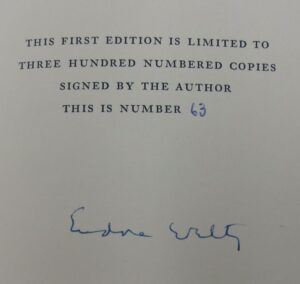 Mrs. Marguerite Cohn heard Miss Welty read the essay on the Poetry Series of the Young Man’s Hebrew Association in New York and asked the author for permission to publish her essay as a limited edition book by her company, the House of Books, in 1957. This is the edition that we have in our collection, which is number 63 of 300 copies printed.
Mrs. Marguerite Cohn heard Miss Welty read the essay on the Poetry Series of the Young Man’s Hebrew Association in New York and asked the author for permission to publish her essay as a limited edition book by her company, the House of Books, in 1957. This is the edition that we have in our collection, which is number 63 of 300 copies printed.
In Dallas, Texas, Hank Coleman founded Pressworks, a small literary fine press publishing company. When Anne Dickson purchased Pressworks in 1981, she inherited short works and poetry by such famous authors as Robert Penn Warren, Joyce Carol Oates, and Donald Barthelme.
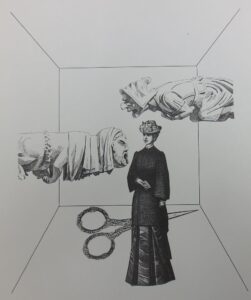
We own a copy of Barthelme’s work, Presents, (1980). Its text consists of numerous brief sketches, most of which involve two naked women, and has four plates of collages done by the author. Our copy is number 150 out of 350 copies printed for sale.
Finally, we have a book of poetry by Oregon’s former Poet Laureate, William Stafford. His book, You and Some Other Characters (1989) was illustrated by his daughter Barbara Stafford and published by Donnell Hunter of the Honeybrook Press. Hunter was a prolific and significant Mormon poet, who ran the Honeybrook Press in Rexburg, Idaho. Our copy of Stafford’s You and Some Other Characters, is one of 328 copies, but it is not numbered nor autographed by the author. What makes this book special is that it was “designed & printed letterpress on Lana Laid paper by Donnell Hunter with hand-set Deepdene type & hand-sewn in Fabriano covers.” 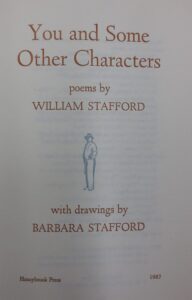
The loving workmanship of hand-set type on fine paper makes Hunter’s physical copy of Stafford’s poetry a tactile pleasure that complements Stafford’s words.
Limited Edition fine press books are works of art created jointly by the author and the publisher / printer. Although these four books are recent publications, their scarcity and / or artistic nature classifies them as rare books, worthy of being shelved next to Shakespeare’s Second Folio, Medieval Books of Hours, and other treasures in the vault at the Mark O. Hatfield Library. If you would like to see them for yourself, please contact Doreen Simonsen, dsimonse@willamette.edu
Bibliography
Barthelme, Donald. Presents. Pressworks, 1980.
Berryhill, Michael. “Booking Dallas.” D Magazine, January 1, 1982, https://www.dmagazine.com/publications/d-magazine/1982/january/booking-dallas/.
Book of the Week — Turkeys and Trees | J. Willard Marriott Library Blog. 19 Nov. 2018, https://blog.lib.utah.edu/book-of-the-week-turkeys-and-trees/.
Davis, Mary Margaret. “Ex-El Pasoan Binds ‘Fine’ Books.” El Paso Times, 29 Aug. 1982, p. 71.
Dickson, Anne. “Letters.” D Magazine, March 1, 1982, https://www.dmagazine.com/publications/d-magazine/1982/march/letters/.
Donnell Hunter | Mormon Literature & Creative Arts Database | HBLL. https://mormonarts.lib.byu.edu/people/donnell-hunter/.
It Came from Beyond Pulp. Ursula K. Le Guin Reads “Gwilan’s Harp.” 2021. YouTube, https://www.youtube.com/watch?v=PzqjHIEE_vI.
Le Guin, Ursula K. Gwilan’s Harp. Lord John Press, 1981.
“Limited Edition Books.” AbeBooks, 3 June 2021, https://www.abebooks.com/books/rarebooks/collecting-guide/what_books_collect/limited-editions.shtml
“Lord John Press.” Worlds Without End, https://www.worldswithoutend.com/publisher.asp?ID=535 .
Newman, Lisa. “Collector Established Lord John Press.” The Clarion-Ledger, 20 Jun. 2015. https://www.clarionledger.com/story/life/2015/06/20/collector-established-lord-john-press/29040303/.
Polk, Noel. “A Eudora Welty Checklist.” The Mississippi Quarterly, vol. 26, no. 4, 1973, pp. 663–93.
Stafford, William. You and Some Other Characters: Poems. Honeybrook Press, 1987.
“The House-of-Books Edition of ‘Place in Fiction.’” Eudora Welty Newsletter, vol. 1, no. 1, 1977, pp. 5–5.
Welty, Eudora. Place in Fiction. House of Books, 1957.
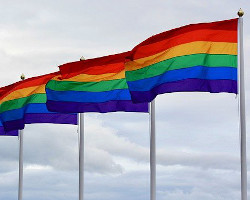 In 1994, Rodney Wilson, a high school teacher in Missouri, decided that a month should be dedicated to celebrating and exploring gay and lesbian history. Along with other teachers and community leaders, they chose October to coincide with National Coming Out Day, which falls on October 11th. Several national organizations endorsed the idea and in 2006, Equality Forum, “a national and international LGBT civil rights organization with an educational focus,” took on the responsibility for coordinating the month-long celebration. LGBTQ+ History Month provides us with the opportunity to recognize and discover the vital role of gay, lesbian, bisexual, and transgender people in American history. Thirty-one important lesbian, gay, bisexual or transgender individuals are highlighted and celebrated throughout the month; this year, Oregon’s Governor, Kate Brown, was chosen as one of these icons and her achievements will be honored on October 10th. In celebration of LGBTQ+ History Month, checkout these recently published books listed on our WU Reads Reading Guide.
In 1994, Rodney Wilson, a high school teacher in Missouri, decided that a month should be dedicated to celebrating and exploring gay and lesbian history. Along with other teachers and community leaders, they chose October to coincide with National Coming Out Day, which falls on October 11th. Several national organizations endorsed the idea and in 2006, Equality Forum, “a national and international LGBT civil rights organization with an educational focus,” took on the responsibility for coordinating the month-long celebration. LGBTQ+ History Month provides us with the opportunity to recognize and discover the vital role of gay, lesbian, bisexual, and transgender people in American history. Thirty-one important lesbian, gay, bisexual or transgender individuals are highlighted and celebrated throughout the month; this year, Oregon’s Governor, Kate Brown, was chosen as one of these icons and her achievements will be honored on October 10th. In celebration of LGBTQ+ History Month, checkout these recently published books listed on our WU Reads Reading Guide.

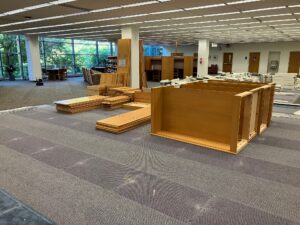
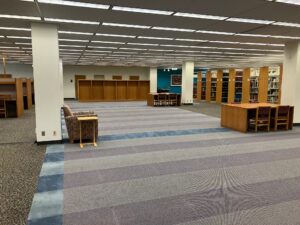


 What do potatoes, mushrooms, and rice have in common? Besides being delicious (depending on who you talk to, of course) and nutritious, these three food sources share the same appreciation month. That’s right–September is National Potato Month, National Mushroom Month, and National Rice Month. Who knew? And did you know that potatoes are grown in all 50 states? And although often considered a vegetable, a mushroom is neither a plant nor animal. In the world of biology, mushrooms make up their own kingdom–Fungi! When it comes to rice, the average American eats 27 pounds of rice a year. Rice constitutes 20% of the world’s dietary energy supply, edging out wheat at 19%. Food scarcity is a growing concern worldwide so it seems appropriate to take a moment to think about the food we consume and appreciate the nutritional value in unassuming food sources such as potatoes, mushrooms, and rice. Checkout related sources from our collection on our
What do potatoes, mushrooms, and rice have in common? Besides being delicious (depending on who you talk to, of course) and nutritious, these three food sources share the same appreciation month. That’s right–September is National Potato Month, National Mushroom Month, and National Rice Month. Who knew? And did you know that potatoes are grown in all 50 states? And although often considered a vegetable, a mushroom is neither a plant nor animal. In the world of biology, mushrooms make up their own kingdom–Fungi! When it comes to rice, the average American eats 27 pounds of rice a year. Rice constitutes 20% of the world’s dietary energy supply, edging out wheat at 19%. Food scarcity is a growing concern worldwide so it seems appropriate to take a moment to think about the food we consume and appreciate the nutritional value in unassuming food sources such as potatoes, mushrooms, and rice. Checkout related sources from our collection on our 
 Details about the paper used for printing this book, what type font was used, who designed the book, who printed the book, and who published the book may be listed. In addition, the author’s autograph may be found on this page, too.
Details about the paper used for printing this book, what type font was used, who designed the book, who printed the book, and who published the book may be listed. In addition, the author’s autograph may be found on this page, too. Mrs. Marguerite Cohn heard Miss Welty read the essay on the Poetry Series of the Young Man’s Hebrew Association in New York and asked the author for permission to publish her essay as a limited edition book by her company, the House of Books, in 1957. This is the edition that we have in our collection, which is number 63 of 300 copies printed.
Mrs. Marguerite Cohn heard Miss Welty read the essay on the Poetry Series of the Young Man’s Hebrew Association in New York and asked the author for permission to publish her essay as a limited edition book by her company, the House of Books, in 1957. This is the edition that we have in our collection, which is number 63 of 300 copies printed.


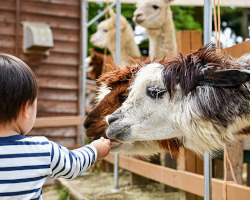 Did you know that the oldest zoo in the United States (in operation since 1874) is the Philadelphia Zoo? And one of the biggest aquariums in the U.S. is located right here on the West Coast at the Monterey Bay Aquarium. The Oregon Zoo, situated on 64 acres in Portland, features over 2,500 animals and attracts more than 1.5 million visitors a year. Zoos and aquariums have been around for centuries, and they have often been the center of controversies. Some of the common and well-founded criticisms revolve around treatment of animals, space concerns, etc. But at their best, zoos and aquariums prioritize animal welfare, conservation, research, and education. June is National Zoo and Aquarium Month and we’re celebrating by featuring a diverse assortment of zoo and aquarium-related titles from our collection on our
Did you know that the oldest zoo in the United States (in operation since 1874) is the Philadelphia Zoo? And one of the biggest aquariums in the U.S. is located right here on the West Coast at the Monterey Bay Aquarium. The Oregon Zoo, situated on 64 acres in Portland, features over 2,500 animals and attracts more than 1.5 million visitors a year. Zoos and aquariums have been around for centuries, and they have often been the center of controversies. Some of the common and well-founded criticisms revolve around treatment of animals, space concerns, etc. But at their best, zoos and aquariums prioritize animal welfare, conservation, research, and education. June is National Zoo and Aquarium Month and we’re celebrating by featuring a diverse assortment of zoo and aquarium-related titles from our collection on our 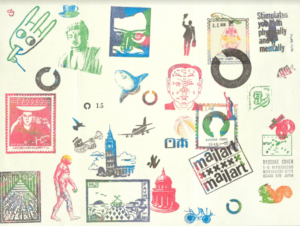
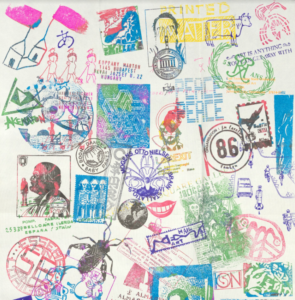
 As the old saying goes, “April showers bring May flowers,” and that is certainly true all around the great Northwest! Flowers, blossoms, and blooms are everywhere this time of year, delighting our eyes and our noses (unless we suffer from allergies). From lilac bushes to dogwood trees, “everything’s coming up roses” right now. Speaking of roses, they are just starting to open up in all their classic beauty and will brighten our lives all summer long. And we can’t forget the delicate beauty of native plants such as trillium and camas. So as the academic year winds down, remember to get outside, enjoy the glorious colors of the flowers that surround us, and “take time to smell the roses!” And while you’re at it, why not check out the
As the old saying goes, “April showers bring May flowers,” and that is certainly true all around the great Northwest! Flowers, blossoms, and blooms are everywhere this time of year, delighting our eyes and our noses (unless we suffer from allergies). From lilac bushes to dogwood trees, “everything’s coming up roses” right now. Speaking of roses, they are just starting to open up in all their classic beauty and will brighten our lives all summer long. And we can’t forget the delicate beauty of native plants such as trillium and camas. So as the academic year winds down, remember to get outside, enjoy the glorious colors of the flowers that surround us, and “take time to smell the roses!” And while you’re at it, why not check out the 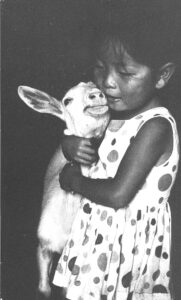
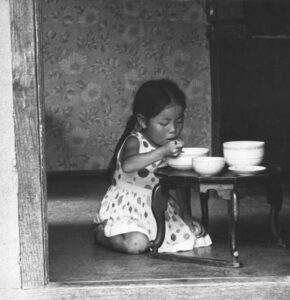
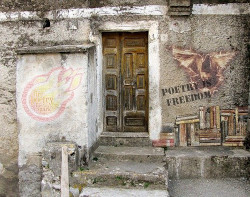 In April 1996, the Academy of American Poets founded National Poetry Month to remind us all “that poets have an integral role to play in our culture and that poetry matters.” One of the primary goals of the month is to “highlight the extraordinary legacy and ongoing achievement of American poets.” Over the years, Poetry Month has become a huge literary observance with readers, students, teachers, librarians, booksellers, publishers, and, of course, poets from around the country participating in this month-long celebration in a whole host of different ways. Many special activities, readings, and virtual events are scheduled to occur during April in honor of poetry. For instance, on April 29, poetry lovers are encouraged to participate in “Poem in Your Pocket Day.” On this day, select a poem, carry it with you, and share it with others wherever you go, including on social media using the hashtag #PocketPoem. Poetry can expose us to the beauty, anger, pain, and joy all around us; it makes us think, wonder, cry, rage, and chuckle. Join us this month in celebrating the magic of poetry and poets!
In April 1996, the Academy of American Poets founded National Poetry Month to remind us all “that poets have an integral role to play in our culture and that poetry matters.” One of the primary goals of the month is to “highlight the extraordinary legacy and ongoing achievement of American poets.” Over the years, Poetry Month has become a huge literary observance with readers, students, teachers, librarians, booksellers, publishers, and, of course, poets from around the country participating in this month-long celebration in a whole host of different ways. Many special activities, readings, and virtual events are scheduled to occur during April in honor of poetry. For instance, on April 29, poetry lovers are encouraged to participate in “Poem in Your Pocket Day.” On this day, select a poem, carry it with you, and share it with others wherever you go, including on social media using the hashtag #PocketPoem. Poetry can expose us to the beauty, anger, pain, and joy all around us; it makes us think, wonder, cry, rage, and chuckle. Join us this month in celebrating the magic of poetry and poets!